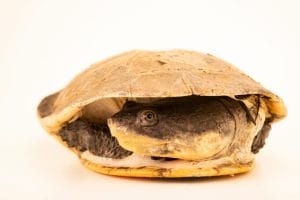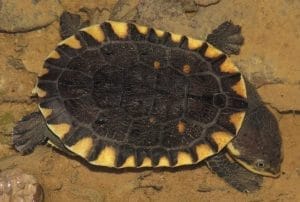Mesoclemmys vanderhaegei (Vander Haeghe’s Toad-headed Turtle)
Home > Turtle Database > Mesoclemmys vanderhaegei (Vander Haeghe’s Toad-headed Turtle)

Mesoclemmys vanderhaegei, commonly known as Vander Haeghe’s Toad-headed Turtle, is a unique freshwater turtle species recognized for its distinctive head shape and vibrant coloration. Native to the diverse ecosystems of South America, this turtle plays a vital role in its habitat’s ecological balance.
Native To These Regions
Bolivia, Brazil, ParaguayNative Turtle Species Map – Find Turtles by Region
Scientific Classification
- Kingdom: Animalia
- Phylum: Chordata
- Class: Reptilia
- Order: Testudines
- Family: Chelidae
- Genus: Mesoclemmys
- Species: Mesoclemmys vanderhaegei
Common Names
- Vander Haeghe’s Toad-headed Turtle
- Vanderhaege’s Turtle
- Toad-headed Side-necked Turtle
This Hilarious Turtle Book Might Know Your Pet Better Than You Do
Let’s be real—most turtle care guides feel like reading a textbook written by a sleep-deprived zookeeper.
This one’s not that.
Told from the snarky point of view of a grumpy, judgmental turtle, 21 Turtle Truths You’ll Never Read in a Care Guide is packed with sarcasm, sass, and surprisingly useful insights.
And hey—you don’t have to commit to the whole thing just yet.
Grab 2 free truths from the ebook and get a taste of what your turtle really thinks about your setup, your food choices, and that weird plastic palm tree.
It’s funny, it’s honest, and if you’ve ever owned a turtle who glares at you like you’re the problem—you’ll feel seen.
Identification
Description
Mesoclemmys vanderhaegei is characterized by its robust, flattened shell, which ranges in color from dark brown to olive green with intricate patterns. The species exhibits a distinctively broad and flattened head, resembling that of a toad, which aids in its aquatic lifestyle. The limbs are strong and webbed, facilitating efficient swimming.
Sexual Dimorphism
Sexual dimorphism in Vander Haeghe’s Toad-headed Turtle is subtle. Males typically have longer tails and slightly larger claws compared to females. Additionally, males may display more vibrant coloration on their heads during the breeding season.
Check more turtles from the Mesoclemmys genus
Native Origin and Distribution
Geographical Range
This turtle species is primarily found in the northern regions of South America, including countries such as Brazil, Venezuela, and Colombia. They inhabit both lowland and foothill areas, adapting to a range of freshwater environments.
Preferred Habitat
Mesoclemmys vanderhaegei thrives in slow-moving rivers, swamps, and marshes with abundant vegetation. These habitats provide ample food sources and shelter from predators. The turtles often bask on submerged logs or vegetation near the water’s edge.
Behavior
Feeding Habits
Vander Haeghe’s Toad-headed Turtle is omnivorous, feeding on a diet that includes aquatic plants, insects, small fish, and invertebrates. Their strong jaws allow them to crack open hard-shelled prey, while their foraging behavior helps control insect populations in their habitat.
Predators
Natural predators of Mesoclemmys vanderhaegei include larger fish, birds of prey, and terrestrial mammals such as raccoons and jaguars. Juvenile turtles are particularly vulnerable to predation by a wider range of predators.
Reproduction
Breeding Season
The breeding season for Vander Haeghe’s Toad-headed Turtle typically occurs during the rainy season, when water levels are high, and food resources are abundant. This timing ensures optimal conditions for egg laying and hatchling survival.
Reproductive Method
Females lay clutches of 5 to 15 eggs in sandy or soft soil nests near water bodies. The incubation period lasts approximately 60 to 90 days, depending on environmental conditions. Hatchlings emerge fully formed and are independent from birth.
Conservation
Extinction Status
Mesoclemmys vanderhaegei is currently listed as Near Threatened on the IUCN Red List.
Threats
Primary threats to this species include habitat destruction due to deforestation, pollution of freshwater systems, and illegal collection for the pet trade. Additionally, climate change poses long-term risks by altering their natural habitats.
Conservation Measures
Conservation efforts focus on habitat preservation through the establishment of protected areas and the implementation of sustainable land-use practices. Anti-poaching laws and regulations on wildlife trade are also crucial in safeguarding this species. Public education campaigns aim to raise awareness about the importance of conserving freshwater turtles.
Economic Importance
Mesoclemmys vanderhaegei contributes to local economies through eco-tourism, attracting nature enthusiasts and researchers interested in biodiversity. Additionally, as part of the ecosystem, they play a role in controlling insect populations and maintaining healthy aquatic environments, which benefits fisheries and agriculture.
Interesting Facts
- Vander Haeghe’s Toad-headed Turtle has a remarkable ability to remain submerged for extended periods, thanks to its efficient respiratory system.
- The species exhibits temperature-dependent sex determination, where the incubation temperature of eggs influences the sex of the hatchlings.
- Their unique head shape not only aids in camouflage among aquatic vegetation but also enhances their ability to forage effectively in murky waters.

About Author
Muntaseer Rahman started keeping pet turtles back in 2013. He also owns the largest Turtle & Tortoise Facebook community in Bangladesh. These days he is mostly active on Facebook.














